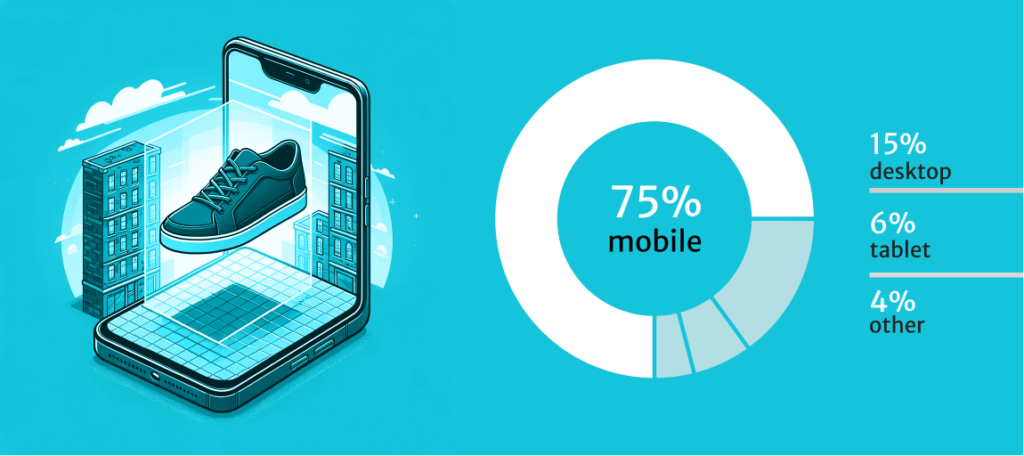Do you recall those long-gone clothing catalogs you used to order from over the phone or through the mail? Show them to Gen-Z and they’ll be amused. The digital transformation of the retail industry, combined with changing consumer behavior, has led to the decline of paper product catalogs, making them completely obsolete. Changes are inevitable. As an e-commerce owner, you need to keep tabs on the shopping preferences of your customers in order to prepare for them in advance, keep your business afloat and thriving. Take a deep dive into the expectations of Gen-Z and Gen-Alpha. Check why creating a proper e-commerce mobile app (and not a PWA!) could be your next strategic decision.
Below, we delve into seven things that younger generations look for in an app, paying special attention to how PWAs and mobile applications stack up against each other.
Who wins? Mobile App vs. PWA
1. It’s all about user experience
1:0 for Mobile Apps
Mobile applications are optimized for performance, offering fast load times, smooth navigation, and a seamless browsing experience. Faster loading times mean higher retention and conversion rates. Much research has been conducted on the impact of slow loading times on user engagement, for example the often quoted Google research, which stated that if a mobile site takes 3 or more seconds to load, half of the users will abandon it.
Mobile apps are specifically designed to leverage device hardware for optimized performance, resulting in a higher-speed, smoother animations and graphics. Not only that, unlike PWAs, which need to take into consideration a broad spectrum of screen sizes that they will be used on, mobile apps are designed specifically for smartphones, which makes their interface much more aligned with user expectations. Additionally, mobile apps are designed to work seamlessly even with limited Internet connectivity, which is crucial for maintaining the comfort of use.
For Gen-Z and Generation Alpha, who have grown up in a digital world, supreme user experience isn’t a bonus but a fundamental expectation that they take for granted. They demand an intuitive and attractive interface, with no latency or cumbersome steps. In comparison to older generations, Gen-Z & Alpha are far less likely to return to an app if their initial experience is marked by inconvenience. The app should thus offer clear and quick access to its functionalities, without unnecessary clicks, and supreme speed. Gen-Z and Alpha rarely part with their smartphones. These generations are ‘always on,’ and their need for instant information raises the bar for app creators. The app needs to work seamlessly even with a limited Internet connection.

2. Hyper-personalization that resonates with individuality
Who wins? Mobile App vs. PWA
1:0 for Mobile Apps
In the realm of personalization, mobile apps outperform PWAs. Mobile apps can tap directly into device capabilities, allowing for sophisticated personalization features such as geo-fenced location-based offers, advanced analytics for personalized recommendations, and more.
Mobile apps also have the inherent technical capability to send real-time, rich-media push notifications directly to the device’s notification center, ensuring immediate visibility. While PWAs have made strides in supporting push notifications, their capabilities are still browser-dependent and generally less robust than mobile apps. This is especially true for iOS devices which support push notifications only in mobile apps and not PWAs.
Gen-Z and Alpha want to feel unique and value a high level of personalization, and they are more likely to engage with brands that offer it. Personalization is a defining characteristic of mobile apps. Features like tailored notifications, recommendations based on previous purchases, and location-based offers, all contribute to a one-of-a-kind user journey.
3. Advanced features for the tech-savvy generations
Who wins? Mobile App vs. PWA
1:0 for Mobile Apps
PWAs, being browser-dependent, have limitations in harnessing more advanced technological features. Conversely, mobile apps are device-integrated, allowing for seamless implementation of advanced technologies like augmented reality and voice recognition. If you want to offer your customers more than the rudimentary shopping capability, mobile apps are the way to go.
Gen-Z and Alpha are at the forefront of technology adoption. Innovative features like augmented reality, voice-assisted shopping, and real-time customer support via AI chatbots hold particular appeal for these tech-savvy demographics, making them more likely to engage with the app. This way, the app serves its basic function (shopping) but in a fun, exciting way (joy).
4. Brands with a mission means loyalty
Who wins? Mobile App vs. PWA
1:1 It’s a tie.
While both mobile apps and PWAs can effectively disseminate brand messages and engage users, mobile apps have a slight technical edge in creating a more immersive and integrated user experience. They can leverage device-specific features such as push notifications, in-app communities, and real-time alerts to engage with the younger generations more proactively. The capability of a mobile app to integrate seamlessly with other apps and system features allows for a more tailored and interactive user experience, further deepening the brand loyalty that younger generations seek.
For younger generations, brand loyalty extends beyond financial incentives. They value brands that take a stand on social issues, engage with their community, and offer a sense of belonging. E-commerce channels can serve as a platform for such multifaceted engagement.
Need an e-commerce mobile app? We can help.
Schedule a meeting5. Content adjusted to their specific behaviors (supported by data)
Who wins? Mobile App vs. PWA
1:0
Mobile apps offer robust analytics capabilities, allowing for a deep understanding of user behavior, preferences, and engagement metrics. This is based on data not just from the app usage, but, more importantly, from data on the device use, for example: the time of day they use their smartphone, the exact day, whether on weekends they are more on the phone or rather offline, etc.
While PWAs offer several analytics capabilities, it’s essential to note that they may not provide the same level of depth and real-time insights as mobile apps, as their capabilities are somewhat dependent on browser support and may not have access to all device-specific features. Therefore, you need to consider their specific analytics requirements and the trade-offs between PWAs and proper mobile apps when making a choice for their digital strategy.
Gen-Z and Alpha generations have specific, often unique, ways of interacting with technology. They are more likely to engage with video content, share products or pages, and appreciate social proof like user reviews. Understanding these nuances can provide businesses with valuable insights to tailor their marketing strategies.
6. The impatience factor: streamlined checkout for reduced friction
Who wins? Mobile App vs. PWA
1:1 It’s a tie.
Mobile apps can drastically simplify the checkout process through features like Apple Pay or Google Wallet for one-click payments, saved payment information, and simplified navigation. While PWAs have made progress in simplifying checkouts, they are generally confined to the limitations of browser-based transactions and cannot offer the same level of seamless integration with stored device data and payment systems. But let’s not look down on PWAs here. Their payment options and checkout capabilities don’t fall far behind those of mobile apps.
Known for their short attention span, the younger generations have little patience for complicated checkout processes. Streamlining this step can significantly reduce cart abandonment rates among these groups.
Why should you care about the trends among the younger generations as an e-commerce owner?
The e-commerce landscape has never been more dynamic. While the overall benefits of mobile applications for this sector are widely recognized, understanding their specific appeal to younger generations—particularly Gen-Z and the emerging Generation Alpha—is crucial for any business aiming for longevity and market leadership, because the younger generations are quickly becoming the dominant force on the market. Meeting their needs means keeping your e-commerce business in good shape.
PWAs and mobile apps – let’s make a quick distinction
Progressive Web Apps (PWAs) are web applications that offer a user experience similar to traditional mobile apps but are accessed through a web browser. Mobile apps, on the other hand, are standalone software applications designed for specific operating systems (iOS, Android) and are typically downloaded from app stores (Apple App Store and Google Play).
Who are Gen-Z and Gen-Alpha?
Gen-Z refers to the generation born between 1997 and 2012, while Gen-Alpha is the cohort born from around 2013 onwards. They are often called “digital natives”, which means that technology is an integral part of their lives. They didn’t know the world before the widespread access to the Internet, unlike their Millennial parents. The comparison in perceiving e-commerce between these generations could be illustrated as follows:
Millennials: “Shopping online is so much more convenient than the old way.”
Gen-Z & Alpha: “Shopping online is just standard.”
On the one hand, this makes the younger generations more likely to engage with mobile e-commerce; on the other hand, they have very high expectations towards them.
Conclusion
As the consumer market increasingly shifts towards younger demographics like Gen-Z and Generation Alpha, e-commerce businesses must adapt or risk obsolescence. Mobile applications offer a compelling array of benefits that are in tune with the expectations and behaviors of these digitally-native consumers. By focusing on delivering superior user experience, hyper-personalization, advanced features, and other useful michanism thatattract young consumers businesses can not only meet the immediate needs but also build a foundation for long-term loyalty and engagement. A mobile app is not just an additional channel; it’s a strategic imperative for businesses aiming to thrive in this ever-changing digital landscape.







